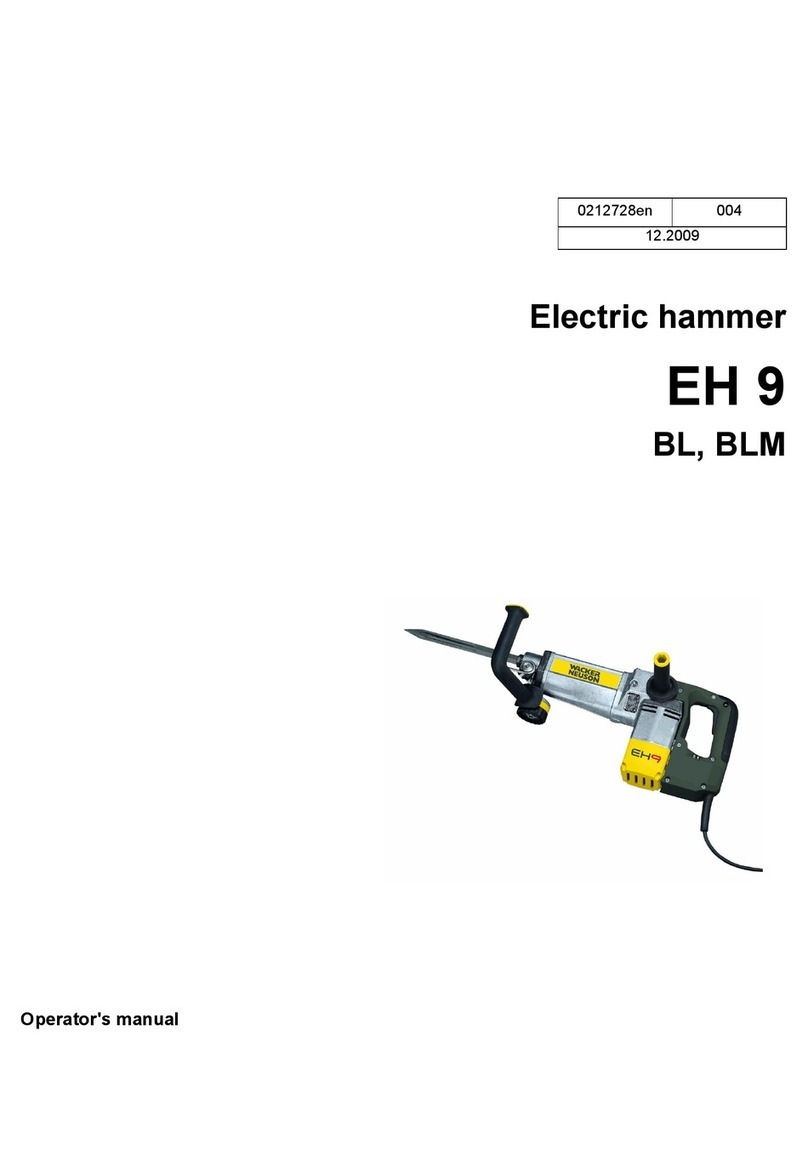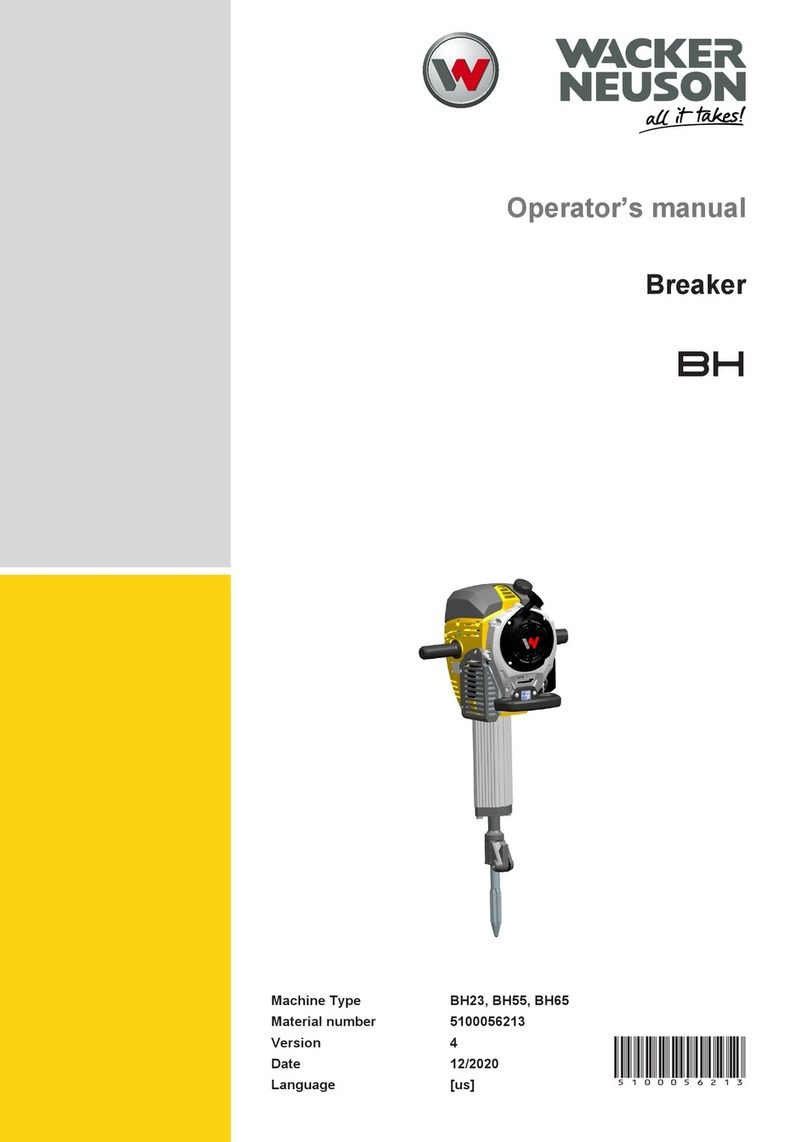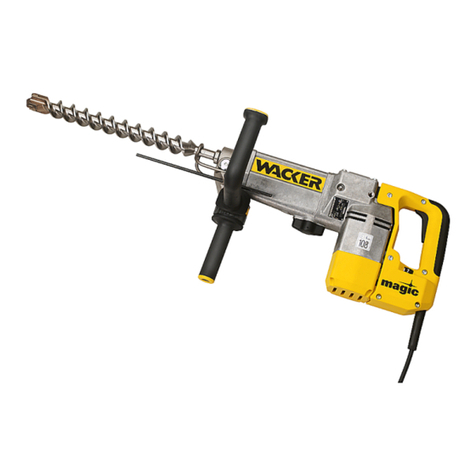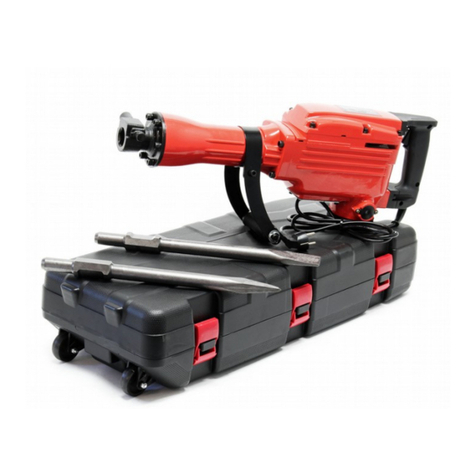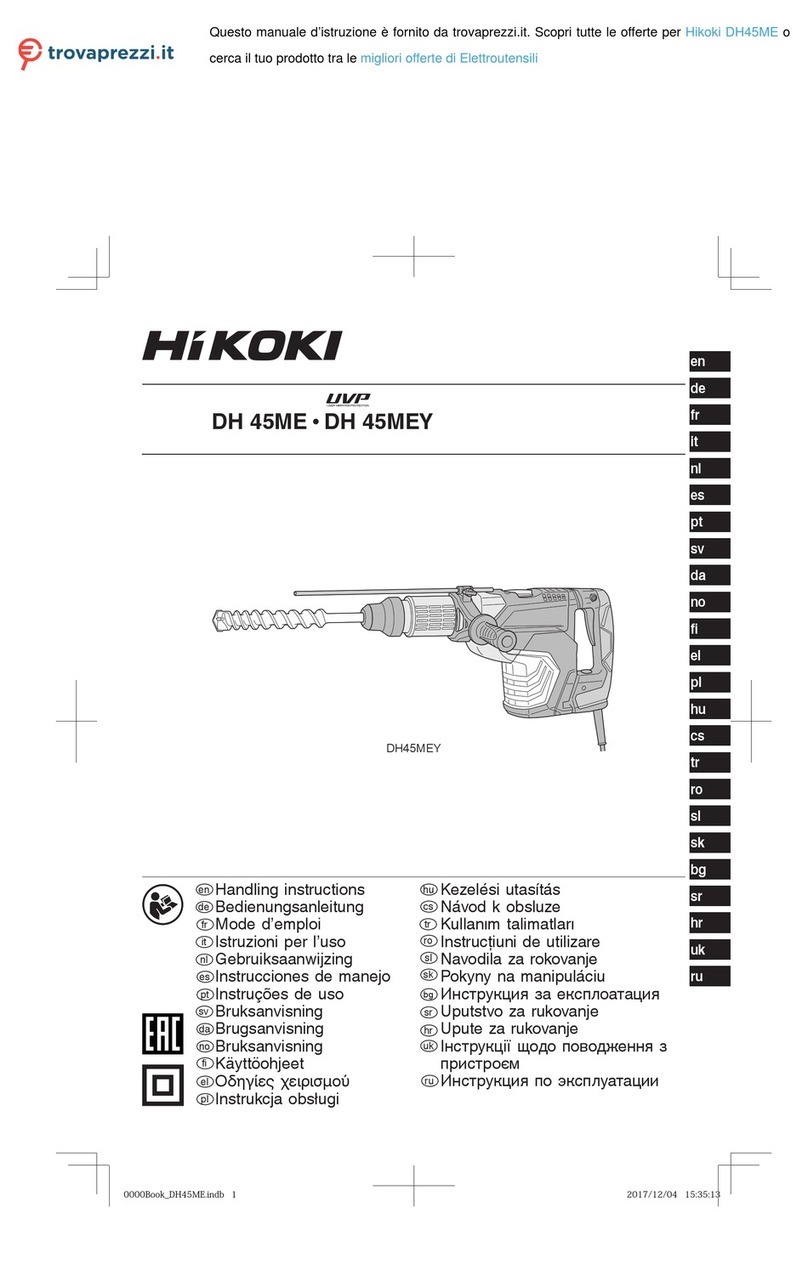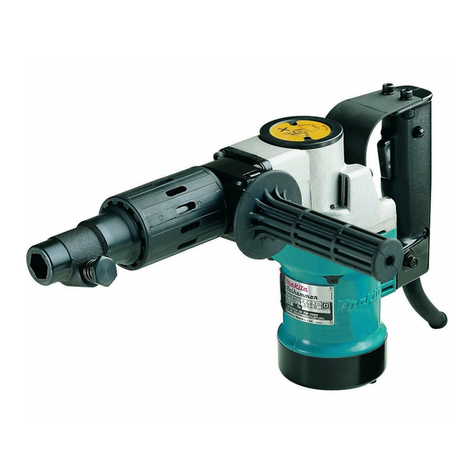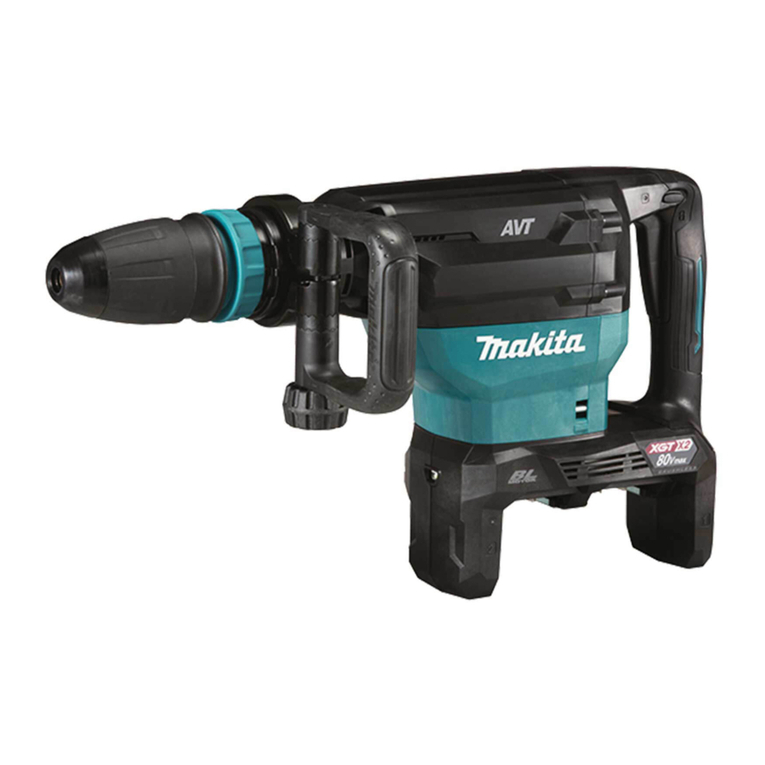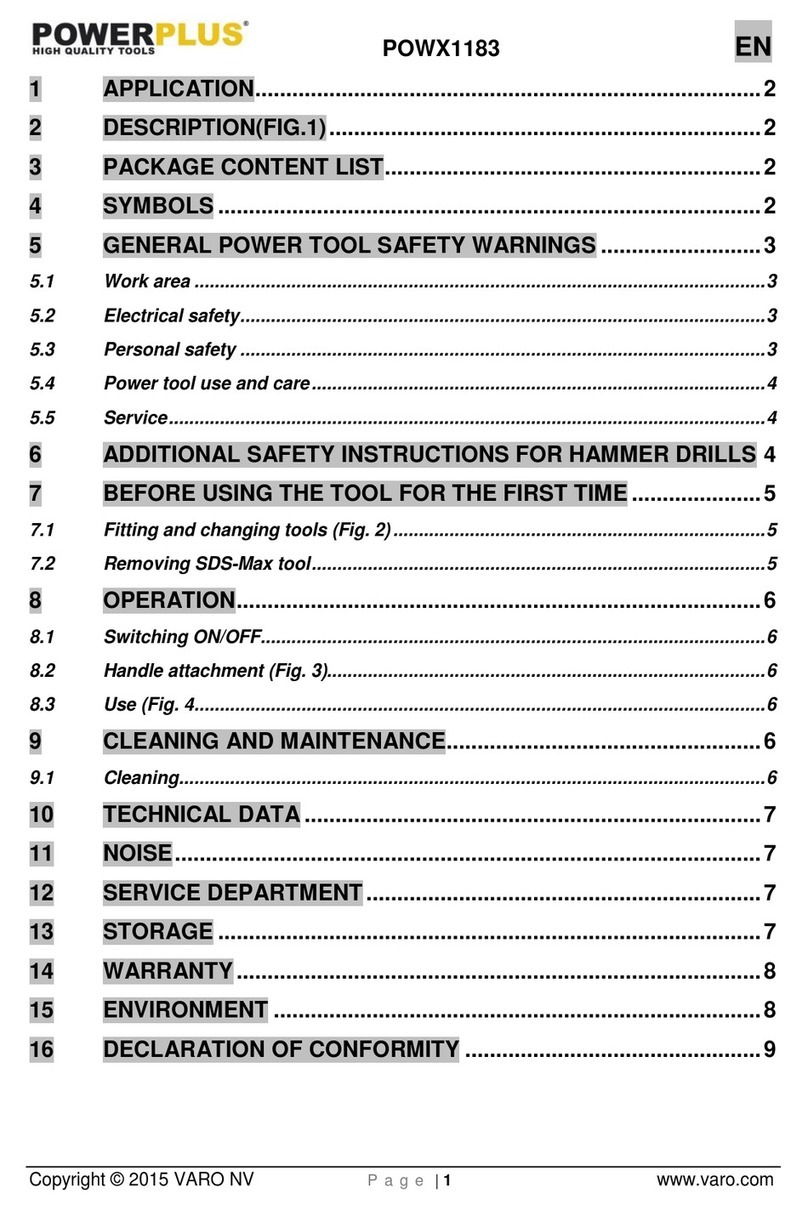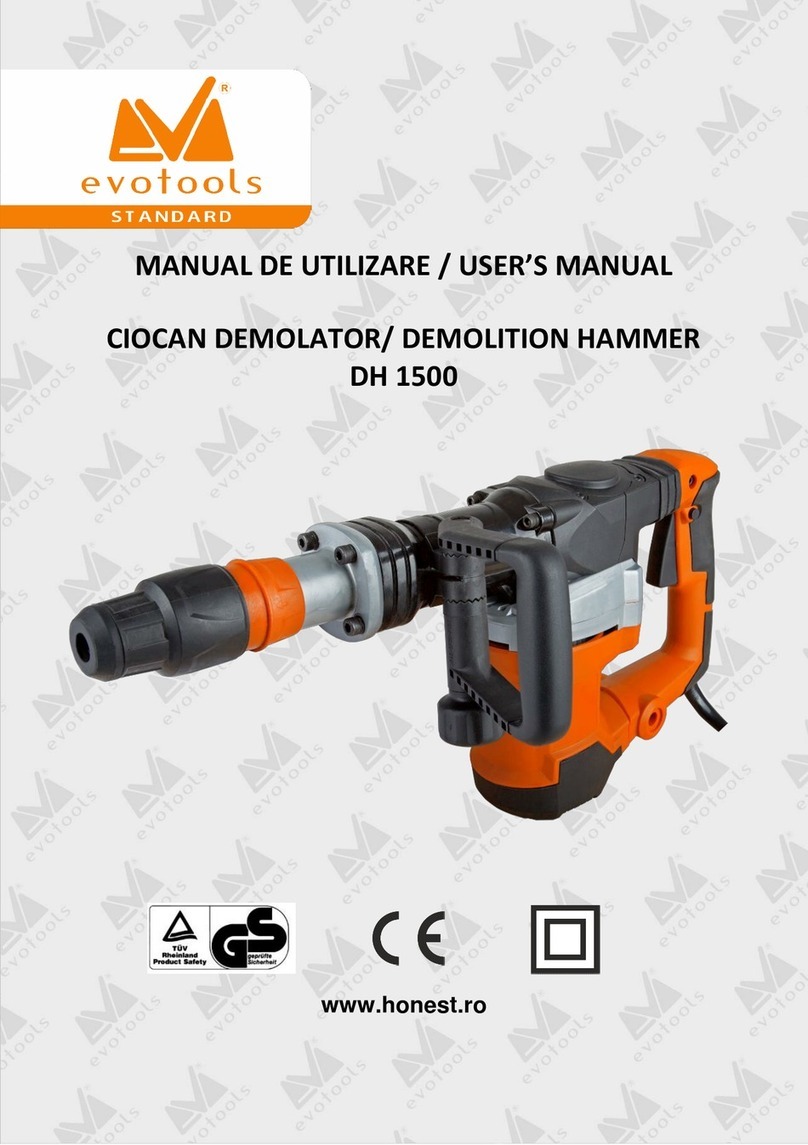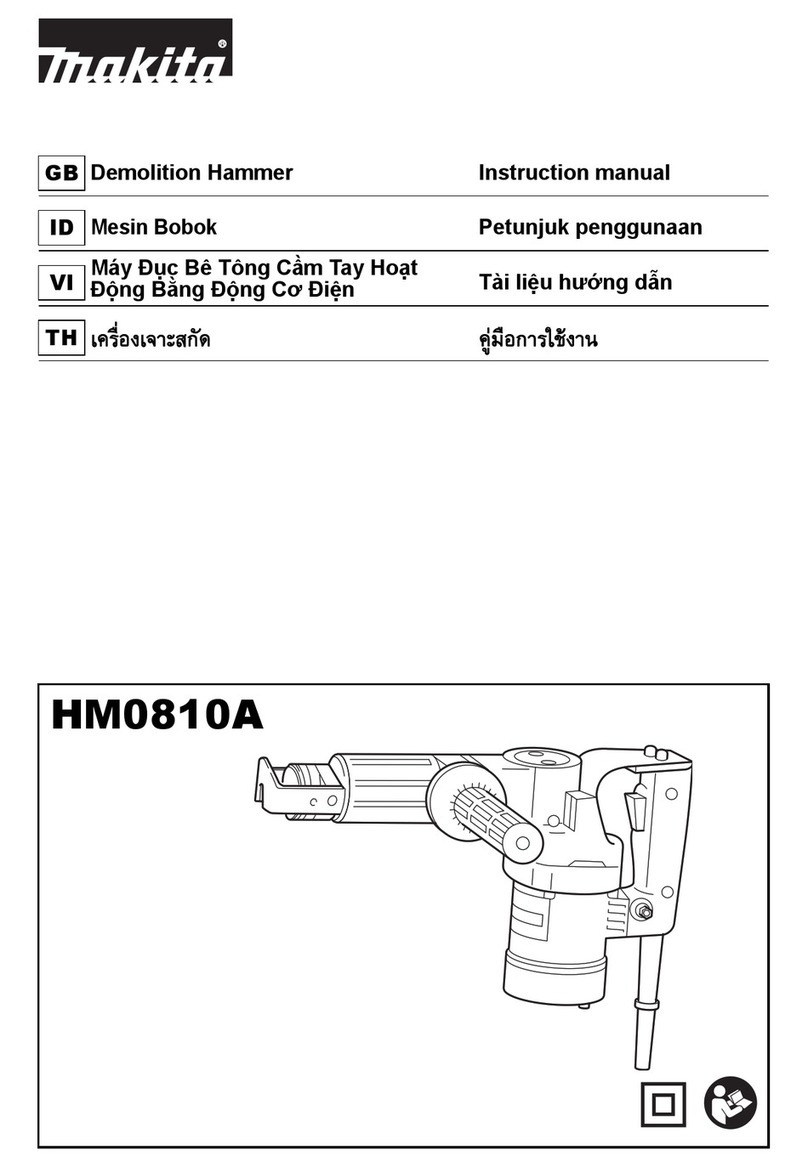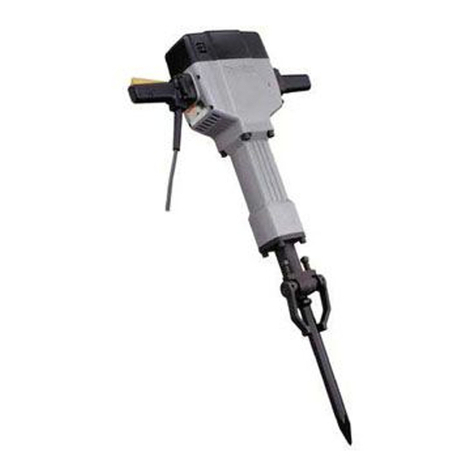Wacker Neuson BH55 User manual

Operator’s manual
Gasoline demolition hammer
BH
55, 65
Model BH
Document 5100004583
Issue 09.2016
Version 06
Language en

100_0000_0001.fm 2
Copyright © 2016 Wacker Neuson Produktion GmbH & Co. KG
Printed in Germany
All rights are reserved, in particular the world-wide applicable copyright, right of duplication and right of
distribution.
This document may only be used by the recipient for the intended purpose. The document may not be
reproduced entirely or partially, or translated into any other language.
Reproduction or translation, even extracts thereof, only with written approval of Wacker Neuson
Produktion GmbH & Co. KG.
Any breach of the statutory provisions, in particular the protection of copyright, will lead to civil and
criminal prosecution.
Wacker NeusonProduktion GmbH & Co. KGis constantly working on the improvement of its products as
part of the technical further development. Therefore, we reserve the right to make changes to the
illustrations and descriptions in this documentation without incurring any obligation to make changes to
machines already delivered.
Errors excepted.
The machine on the cover may have special equipment (options).
Manufacturer
Wacker Neuson Produktion GmbH & Co. KG
Preussenstrasse 41
80809 Munich
www.wackerneuson.com
Tel.: +49-(0)89-354 02-0
Fax: +49-(0)89-354 02-390
Translation of the original operator's manual in German

35100004583IVZ.fm
1 Preface ...................................................................................................................................5
2 Introduction ...........................................................................................................................6
2.1 Using the manual......................................................................................................................... 6
2.2 Storage location of the manual.................................................................................................... 6
2.3 Accident prevention regulations................................................................................................... 6
2.4 More information.......................................................................................................................... 6
2.5 Target group................................................................................................................................ 6
2.6 Explanation of symbols................................................................................................................ 6
2.7 Wacker Neuson Contact partner ................................................................................................. 7
2.8 Disclaimer.................................................................................................................................... 7
2.9 Product identification of the machine........................................................................................... 7
3 Safety ......................................................................................................................................8
3.1 Principle....................................................................................................................................... 8
3.2 Proper use................................................................................................................................... 8
3.3 Structural modifications ............................................................................................................... 8
3.4 Requirements for operation......................................................................................................... 8
3.5 Exclusion of liability...................................................................................................................... 9
3.6 Operator's manual ....................................................................................................................... 9
3.7 Country-specific regulations ........................................................................................................ 9
3.8 Operator's controls....................................................................................................................... 9
3.9 Qualification of the operating personnel.................................................................................... 10
3.10 Operating company responsibilities........................................................................................... 10
3.11 Protective gear........................................................................................................................... 10
3.12 Transport ................................................................................................................................... 11
3.13 Operating safety ........................................................................................................................ 11
3.14 Safety during the operation of hand machines .......................................................................... 12
3.15 Safety during the operation of combustion engines................................................................... 12
3.16 Maintenance.............................................................................................................................. 14
3.17 Safety devices ........................................................................................................................... 15
4 Safety and information labels ............................................................................................16
5 Structure and function ........................................................................................................18
5.1 Scope of delivery....................................................................................................................... 18
5.2 Application................................................................................................................................. 18
5.3 Functional description................................................................................................................ 18
5.4 Variants...................................................................................................................................... 18
6 Components and operator's controls ............................................................................... 19
7 Transport .............................................................................................................................. 21
8 Initial start up .......................................................................................................................22
9 Use and operation ...............................................................................................................23
9.1 Prior to starting the machine...................................................................................................... 23
9.2 Adjusting the machine ............................................................................................................... 23
9.3 Operation with remote cut-off .................................................................................................... 23
9.4 Operation without remote cut-off ............................................................................................... 23
9.5 Changing tools........................................................................................................................... 24
9.6 Starting up ................................................................................................................................. 24
9.7 Operating the machine .............................................................................................................. 27
9.8 Decommissioning ...................................................................................................................... 28
10 Maintenance .........................................................................................................................29
10.1 Maintaining the Emission control system................................................................................... 29
10.2 Maintenance personnel qualifications........................................................................................ 29
10.3 Maintenance schedule............................................................................................................... 29
Inhalt

5100004583IVZ.fm 4
10.4 Maintenance work...................................................................................................................... 30
11 Malfunctions ........................................................................................................................34
12 Storage .................................................................................................................................35
13 Accessories .........................................................................................................................36
13.1 Truck.......................................................................................................................................... 36
14 Technical data ......................................................................................................................37
14.1 BH55.......................................................................................................................................... 37
14.2 BH55rw...................................................................................................................................... 39
14.3 BH65.......................................................................................................................................... 41
15 Emission Control Systems Information and Warranty ....................................................44
15.1 Emission Control System Background Information ................................................................... 44
15.2 Limited Defect Warranty for Wacker Neuson Emission Control Systems ................................. 44
16 Glossary ...............................................................................................................................48
16.1 Use of oxygenated fuels............................................................................................................ 48
EC Declaration of Conformity ....................................................................................50
EC Declaration of Conformity ....................................................................................51
EC Declaration of Conformity ....................................................................................52
DIN EN ISO 9001 Zertifikat . . . . . . . . . . . . . . . . . . . . . . . . . . . . . . . . . . . . . . . . . . .31

1 Preface
5100_0000_0002.fm
1 Preface
Thisoperator'smanualcontainsimportantinformationandproceduresforthesafe,properandeconomic
operation of this Wacker Neuson machine. Carefully reading, understanding and observing is an aid to
avoiding hazards, repair costs and downtime, and therefore to increasing the availability and service life
of the machine.
This operator's manual is not a manual for extensive maintenance or repair work. Such work should be
carried out by Wacker Neuson service or by technically trained personnel. The Wacker Neuson machine
should be operated and maintained in accordance with this operator's manual. An improper operation or
improper maintenance can pose dangers. Therefore, the operator's manual should be constantly
available at the location of the machine.
Defective machine parts must be exchanged immediately!
If you have any questions concerning the operation or maintenance, a Wacker Neuson contact person
is always available.

2 Introduction
100_0000_0013.fm 6
2 Introduction
2.1 Using the manual
This manual is to be considered part of the machine and should be carefully stored during the entire
service life of the machine. This manual shall be transferred to subsequent owners or users of the
machine.
2.2 Storage location of the manual
This manual is part of the machine and must be kept in the immediate vicinity of the machine and made
accessible to staff at all times.
If this manual is lost, or if a second copy is required, there are two options to obtain a replacement:
Download from the Internet www.wackerneuson.com
Contact your Wacker Neuson contact partner.
2.3 Accident prevention regulations
In addition to the notes and safety instructions in this manual, the local accident prevention regulations
as well as the national health and safety regulations apply.
2.4 More information
This manual applies to various machine types from one product series. For this reason, some figures
may vary slightly in appearance from the machine purchased. Depending on the model, there may be
descriptions of components that are not included in the standard package.
The information contained in this manual is based on machines manufactured up to the time of printing.
Wacker Neuson reserves the right to change this information.
The manufacturer shall immediately include any modifications or additions in this manual.
2.5 Target group
Individuals working with this machine must be regularly trained on the dangers of handling the machine.
This operator's manual is intended for the following persons:
Operating personnel:
These individuals have been trained on the machine and informed about the possible dangers in the
event of improper conduct.
Technically trained personnel:
These people have professional training as well as additional knowledge and experience. They are able
to assess the tasks assigned to them and recognize possible dangers.
2.6 Explanation of symbols
This manual contains specially emphasized safety instructions in the following categories: DANGER,
WARNING, CAUTION and NOTICE.
Before performing any work on or with this machine, the notes and safety instructions must be read and
understood. All notes and safety instructions in this manual must be passed on to the maintenance,
repair, and transport personnel.
DANGER
This combination of symbol and signal word indicates a hazardous situation that will lead
to death or serious injury if it is not avoided.
WARNING
This combination of symbol and signal word indicates a hazardous situation that can lead
to death or serious injury if it is not avoided.
CAUTION
This combination of symbol and signal word indicates a hazardous situation that can lead
to minor injury or damage to the machine if it is not avoided.

2 Introduction
7100_0000_0013.fm
2.7 Wacker Neuson Contact partner
Depending on the country, the Wacker Neuson contact partner is a Wacker Neuson service department,
a Wacker Neuson affiliate, or a Wacker Neuson dealer.
On the Internet at www.wackerneuson.com.
The manufacturer's address can be found at the beginning of this manual.
2.8 Disclaimer
For the following violations, Wacker Neuson dismisses any liability for personal injury or material
damage:
Failure to follow this manual.
Unintended use.
Deployment of untrained personnel.
Using non-approved spare parts and accessories.
Improper handling.
Structural modifications of any kind.
Failure to observe the "General Terms and Conditions" (GT&Cs).
2.9 Product identification of the machine
Data of the nameplate
The nameplate contains information that uniquely identifies this machine. This information is required for
ordering spare parts and when inquiring about technical issues.
Enter information about the machine in the following table:
NOTICE
Supplementary information.
Designation Your information
Group and model
Year of manufacture
Serial number
Version no.
Item number

3 Safety
100_0302_si_0001.fm 8
3 Safety
3.1 Principle
State of the art
This machine has been constructed with state-of-the-art technology according to the recognized rules of
safety. Nevertheless, when used improperly, dangers to the life and limb of the operator or to third
persons or damage to the machine or other materials cannot be excluded.
3.2 Proper use
The machine must only be used for the following purposes:
Breaking off concrete and asphalt and soil that is full of boulders.
Breaking off concrete, masonry and other construction materials, untouched and frozen ground.
Scarifying roads and concrete, asphalt, tar and wooden and stone paving.
Cutting clay, loam, peat and salts.
Breaking up compacted soils.
Ramming in posts, probes and grounding rods.
To tamp sleepers in track construction.
The machine may only be used with tools that are intended for use with the machine and the material
being worked on.
The machine may not be used for the following purposes:
Working on hazardous materials such as asbestos.
Its proper use also includes the observance of all instructions contained in this operator's manual as well
as complying with the required service and maintenance instructions.
Any other use is regarded as improper. Any damage resulting from improper use will void the warranty
and the liability on behalf of the manufacturer. The operator assumes full responsibility.
3.3 Structural modifications
Never attempt to modify the machine without the written permission of the manufacturer. To do so will
endanger your safety and the safety of other people! In addition, this will void the warranty and the
liability on behalf of the manufacturer.
Especially the following are cases of structural modifications:
Opening the machine and the permanent removal of components from Wacker Neuson.
Installingnewcomponentswhich arenot from WackerNeuson and notequivalentto the original parts
in design and quality.
Installation of accessories which are not from Wacker Neuson.
It is no problem to install spare parts from Wacker Neuson.
It is no problem to install accessories that are available in the Wacker Neuson product range of your
machine. Please refer to the installation regulations in this operator's manual. They can be found on the
Internet under www.wackerneuson.com.
Do not drill into the housing, e.g. to install signs. Water could penetrate the housing and damage the
machine.
3.4 Requirements for operation
The ability to operate the machine safely requires:
Proper transport, storage and setup.
Careful operation.
Careful service and maintenance.
Operation
Operate the machine only as intended and only when in proper working condition.
Operate the machine in a safety-conscious manner with all safety devices attached and enabled. Do not
modify or disable any safety devices.
Before starting operation, check that all control and safety devices are functioning properly.
Never operate the machine in a potentially explosive environment.

3 Safety
9100_0302_si_0001.fm
Maintenance
Regular maintenance is required in order for the machine to operate properly and reliably over time.
Failure to perform adequate maintenance reduces the safety of the machine.
Strictly observe the prescribed maintenance intervals.
Do not use the machine if it requires maintenance or repairs.
Malfunctions
If you detect a malfunction, you must shut down and secure the machine immediately.
Eliminate the malfunctions that impair safety immediately!
Have damaged or defective components replaced immediately!
For further information, refer to chapter Malfunctions.
Spare parts, accessories
Use only spare parts from Wacker Neuson or such that are equivalent to the original parts in design and
quality.
Only use accessories from Wacker Neuson.
Non-compliance will exempt the manufacturer from all liability.
3.5 Exclusion of liability
Wacker Neuson will refuse to accept liability for injuries to persons or for damage to materials in the
following cases:
Structural modifications.
Improper use.
Failure to comply with this operator's manual.
Improper handling.
Using of spare parts which are not from Wacker Neuson and not equivalent to the original parts in
design and quality.
Using of accessories which are not from Wacker Neuson.
3.6 Operator's manual
Always keep the operator's manual near the machine or near the worksite for quick reference.
If you have misplaced the operator's manual or require an additional copy, contact your Wacker Neuson
representative or download the operator's manual from the Internet (www.wackerneuson.com).
Always hand over this operator's manual to other operators or to the future owner of the machine.
3.7 Country-specific regulations
Observe the country-specific regulations, standards and guidelines in reference to accident prevention
and environmental safety, for example those pertaining to hazardous materials and wearing protective
gear.
Complement the operator's manual with additional instructions taking into account the operational,
regulatory, national or generally applicable safety guidelines.
3.8 Operator's controls
Always keep the operator's controls of the machine dry, clean and free of oil or grease.
Operating elements such as ON/OFF switch, gas handles etc. may not be locked, manipulated or
changed without authorization.
Checking for signs of damage
Inspect the machine when it is switched off for any signs of damage at least once per work shift.
Do not operate the machine if there is visible damage or defects.
Have any damage or defects eliminated immediately.
Supervision
Never leave the machine running unattended!

3 Safety
100_0302_si_0001.fm 10
3.9 Qualification of the operating personnel
Operator qualifications
Only trained personnel are permitted to start and operate the machine. The following rules also apply:
You are physically and mentally fit.
You have received instruction on how to independently operate the machine.
You have received instruction in the proper use of the machine.
You are familiar with required safety devices.
You are authorized to start machines and systems in accordance with the standards governing
safety.
Your company or the operator has assigned you to work independently with this machine.
Incorrect operation
Incorrect operation or misuse by untrainedpersonnel can endangerthe health and safety of the operator
or third persons and also cause machine and material damage.
3.10 Operating company responsibilities
The operating company must make the operator's manual available to the operator and ensure that the
operator has read and understood it.
Work recommendations
Please observe the recommendations below:
Work only if you are in a good physical condition.
Work attentively, particularly as you finish.
Do not operate the machine when you are tired.
Carry out all work calmly, circumspectly and carefully.
Never operate the machine under the influence of alcohol, drugs or medication. This can impair your
vision, reactions and your judgment.
Work in a manner that does not endanger others.
Ensure that no persons or animals are within the danger zone.
3.11 Protective gear
Work clothing
Clothing should be appropriate, i.e. should be close-fitting but not restrict your movement.
When on construction sites, do not wear long hair loosely, loose clothing or jewelry including rings.
These objects can easily get caught or be drawn in by moving machine parts.
Only wear clothing made of material that is not easily flammable.
3.11.1 Personal protective gear
Wear personal protective gear to avoid injuries or health hazards:
Non-skid, hard-toed shoes.
Work gloves made of durable material.
Overalls made of durable material.
Hard hat.
Ear protection.
Face protection.
Eye protection.
Breathing protection in the case of dusty ambient air.
Ear protection
This machine generates noise that exceeds the country-specific permissible noise levels (individual
rating level). It may therefore be necessary to wear ear protection. You can find the exact value in the
chapter Technical Data.
When wearing ear protection while working, you must pay attention and exercise caution because your
hearing is limited, e.g. in case someone screams or a signal tone sounds.
Wacker Neuson recommends that you always wear ear protection.

3 Safety
11 100_0302_si_0001.fm
3.12 Transport
Switching off the machine
Before you transport the machine, it must be switched off, and the engine must be given sufficient time
to cool down.
Emptying the tank
Wacker Neuson recommends that the fuel tank be emptied and the carburetor run dry prior to
transporting it. Fuel could run out, e.g. if the machine is tilted.
Observe the national safety guidelines and the hazardous materials regulations that apply to the
respective means of transportation.
Transporting the machine
Secure the machine on the transport device against tilting, falling or slipping.
Lifting the machine
A falling machine can cause serious injuries.
The machine has no lifting or lashing points.
When lifting the machine, secure it in a closed transport container or similar in order to prevent it from
toppling, falling or slipping away.
Restarting
Machines, machine parts, accessories or tools that were detached for transport purposes must be re-
mounted and fastened before restarting.
Only operate in accordance with the operating instructions.
3.13 Operating safety
3.13.1 Explosible environment
Never operate the machine in a potentially explosive environment.
3.13.2 Work environment
Familiarize yourself with your work environment before you start work. This includes e.g. the following
items:
Obstacles in the work and traffic area.
Load-carrying capacity of the ground.
The measures needed to cordon off the construction site from public traffic in particular.
The measures needed to secure walls and ceilings.
Options available in the event of an accident.
3.13.3 Safety in the work area
When working with the machine especially pay attention to the following points:
Electric lines or pipes in work area.
Gas lines or water lines in the work area.
Materialbecomingseparated,dropping down orejected.Make surethatyou do notput otherpersons
in danger.
Pay maximum attention in the vicinity of drops or slopes. Risk of falling.
Maintain a sufficient distance from flammable materials.
3.13.4 Checks before starting work
Check the following points before beginning work:
Condition of tools.
Machine settings.
3.13.5 Starting the machine
Observe the safety information and warning notices located on the machine and in the operator's
manual.
Never attempt to start a machine that requires maintenance or repairs.
Start the machine as described in the operator's manual.

3 Safety
100_0302_si_0001.fm 12
Vertical stability
Always make sure that you stand firmly when working with the machine. This applies particularly when
working on scaffoldings, ladders, uneven or slippery floors etc.
Caution with hot parts
Do not touch any hot parts such as tools, tool holders, mufflers or guide cylinders during operation or for
a short period afterwards. These parts can become very hot and can cause severe burns.
Caution with movable parts
Keep your hands, feet and loose clothing away from moving or rotating machine parts.
Caution with toxic materials
Some materials may contain toxic chemicals which are released during demolition. Therefore personal
protective equipment must be worn to prevent inhalation of and skin contact with work dust.
Do not direct towards people
Do not direct the machine towards people in the vicinity during operation. The tool might be flung out and
cause serious injuries.
No persons endangered
Be sure that no persons are endangered by flying or falling materials. Always work very attentively, and
anticipate potential hazards.
3.13.6 Switching off the machine
Switch off the engine in the following situations:
Before breaks.
If you are not using the machine.
Before storing the machine, wait until it has completely stopped running.
Store the machine or put it down in such a way that it cannot tilt, fall down or slip.
3.13.7 Storage
Set the machine down or store it securely so that it cannot tilt, fall down or slip.
Storage location
After operation, allow the machine to cool and then store it in a sealed-off, clean and dry location
protected against frost and inaccessible to children.
3.14 Safety during the operation of hand machines
Safe working with hand machines
Secure loose workpieces with suitable methods.
While working, as a rule hold the machine on the provided handles with both hands.
While working, hold the machine in such a way that hand injuries are avoided when hitting hard objects.
Setting the hand machine down properly
Set the machine down carefully. Do not drop the machine to the floor or from greater heights. Dropping
the machine can cause injuries to other persons or the machine itself can be damaged.
Safe working with the hammer
Keep the tool holder closed during operation.
3.15 Safety during the operation of combustion engines
3.15.1 Checking for signs of damage
Check the engine while switched off for leaks and cracks in the fuel line, tank and fuel cap at least once
per work shift.
Do not operate the machine if there is visible damage or defects.
Have any damage or defects eliminated immediately.

3 Safety
13 100_0302_si_0001.fm
3.15.2 Dangers during operation
Combustion engines can be dangerous, particularly during operation and when refueling.
Read and follow all safety instructions. Otherwise there is a risk of personal injury and/or damage to
property!
Do not start the engine near spilt fuel or if you smell fuel – this may cause an explosion!
Remove the machine from such areas.
Remove the spilt fuel immediately!
Not changing the engine speed
Do not change the preset engine speed, as this may cause engine damage.
Preventing fires
Open flames and smoking are strictly prohibited in the immediate vicinity of the machine.
Make sure that waste, suchas paper, dry leaves or grass do not accumulate around the exhaust muffler.
The waste materials may ignite.
3.15.3 Safety precautions when refueling
Please observe the following safety-relevant instructions when refueling:
Do not refuel near open flames.
Do not smoke.
Turn off the engine before refueling and allow it to cool down.
Refuel in a well-ventilated environment.
Wear fuel-proof protective gloves and, if there is the possibility of spraying, protective goggles and
clothing.
Do not inhale fuel vapors.
Avoid skin and eye contact with fuel.
For refueling, use clean tools such as a hopper.
Do not spill fuel, especially onto hot parts.
Remove any spilt fuel immediately.
Use the correct fuel grade.
Do not mix fuel with other liquids.
Fill the tank only up to the maximum marking. If there is no Maximum marking, do not fill up the tank
completely.
Lock the fuel cap securely after refueling.
Operation in closed rooms
In closed or partially closed rooms such as tunnels, drifts or deep trenches, ensure sufficient ventilation
by, for example, providing a powerful exhaust air fan.
Danger of poisoning! Do not inhale exhaust fumes. They contain toxic carbon monoxide that can lead
to unconsciousness or death.
Caution with hot parts
Do not touch any hot parts such as the engine block or exhaust muffler during operation or directly
afterwards. These parts can become very hot and cause severe burns.
Not using starter sprays
Highly flammable starter sprays pose a fire hazard.
Do not use any starter sprays.
Starter sprays are highly flammable and can cause backfiring and engine damage.
Shutting off the fuel tap
When the machine stops, shut off the fuel tap.
Cleaning the engine
Clean the engine when it is cool to remove any dirt.
Do not use gasoline or solvents. Danger of explosion!

3 Safety
100_0302_si_0001.fm 14
3.15.4 Health hazard due to exhaust fumes
Warning
The engine's exhaust fumes contain chemicals which are known to the State of California to cause
cancer, congenital defects or other reproductive anomalies.
3.15.5 Notes on the EPA engine
3.16 Maintenance
Maintenance work
Service and maintenance work must only be carried out to the extent described in these operating
instructions. All other procedures must be performed by your Wacker Neuson representative.
For further information, refer to chapter Maintenance.
Switching off the engine
Before carrying out care or maintenance work, switch off the engine and allow it to cool down.
For gasoline powered engines, you must pull off the spark plug cap.
Handling operating fluids safely
Observe the following points when handling operating fluids, e.g. fuels, oils, greases, coolants etc.:
Always wear personal safety clothing.
Avoid skin and eye contact with operating fluids.
Do not inhale or swallow operating fluids.
In particular, avoid contact with hot operating fluids. Burn and scalding hazard.
Dispose of replaced or spilled operating fluids according to the applicable regulations for
environmental protection.
If operating fluids escape from the machine, cease operation of the machine and have it repaired
immediately by your Wacker Neuson representative.
Cleaning
Always keep the machine clean and be sure to clean it each time you have finished using it.
Do not use gasoline or solvents. Danger of explosion!
Do not use high pressure washers. Permeating water can damage the machine. When electrical
equipment is present, this can pose a serious injury risk from electric shocks.
Cleaning the zerk fitting
Wipe the zerk fitting with a clean cloth after the lubrication of the machine. There is a danger of
electrocution if there is excessive grease on the zerk fitting.
CAUTION
This machine is equipped with an EPA-certified engine.
Modifying the motor speed influences the EPA certification and emission. The motor may
only be set by a skilled technician.
For more detailed information, contact your nearest motor or Wacker Neuson
representative.

3 Safety
15 100_0302_si_0001.fm
3.17 Safety devices
Burn protector
The burn protector the operator against emitted heat.
WARNING
Danger of injury due to open moving parts.
Only operate the machine with properly installed and functioning safety devices.
Do not modify or remove safety devices.
WARNING
Hot exhaust.
Touching it can cause burns.
Only operate the machine with properly installed safety devices.
Do not modify or remove safety devices.
Item Designation
1 Burn protector

4 Safety and information labels
100_0302_ls_0001.fm 16
4 Safety and information labels
Your machine has adhesive labels containing the most important instructions and safety information.
Make sure that all the labels are kept legible.
Replace any missing or illegible labels.
Item Label Description
1 Smoking and open flames are prohibited. Danger of fire.
2 Wear personal protective gear to avoid injuries or health
hazards:
Ear protection.
Eye protection.
Read the operator's manual.
3 OFF switch.
4 Caution.
Warning of hot surface.
5 Guaranteed sound power level.
6 US machines Warning.
7 US machines Danger.
8 Japan machines Use only specified spark plug.
0
2
1
9
1
8
0
0219174
0219261
WARNING
WARNUNG
ADVERTENCIA
ADVERTISSEMENT
0219176
0218955
DANGER
GEFAHR
PELIGRO
DANGER
0219178
0222682

4 Safety and information labels
17 100_0302_ls_0001.fm
9 Japan machines Grease every 20 hours with lithium grease. Do not use other
grease. (grease at central grease point)
10 Japan machines Total vibration value of the acceleration.
Item Label Description
0222684
0222704

5 Structure and function
100_0302_sf_0002.fm 18
5 Structure and function
5.1 Scope of delivery
The scope of delivery includes:
Machine.
Operator’s manual.
5.2 Application
Use the machine only as intended, see chapter Safety, Proper use.
5.3 Functional description
Principle
The machine is a demolition hammer with a pneumatic percussion system.
It is driven by a gasoline engine.
The rotary movement of the drive engine is converted into a stroke movement via a centrifugal clutch, a
single-stage spur gear unit, and a crank mechanism.
The piston is moved forwards and backwards by the crank gear, this compresses the air (forward
movement) or generates a partial vacuum (backward movement). Due to change in pressure the
percussion piston is moved forward and backwards (air cushion percussion system) and hits the tool.
The hood and operator's controls are decoupled from the percussion system by a spring system. This
springsystemkeepsvibrationsawayfrom the operator'sbody ifhefor example presses hisbodyagainst
the hood while working.
5.4 Variants
The following different versions were specified in the technical data for the device types:
rs – Integrated shut-off device
The machine has an integrated shut-off device for connecting to an external remote cut-off.
Via the remote cut-off, you can switch off several machines from a central location. This is for the safety
of the operators, e.g. in track construction work.
If you wish to use your machine with a remote cut-off, please contact your Wacker Neuson
representative.
rw
The machine is especially designed for use in track construction.

6 Components and operator's controls
19 100_0302_cp_0001.fm
6 Components and operator's controls
Recoil starter
The recoil starter starts the engine.
In certain operating situations, e.g. when ramming in posts and grounding rods, it can be advantageous
tochangethe tractiondirectionof the recoilstarter, i.e.thepositionofthe recoil starter should be different
to the standard position. In such cases, consult the Service Department of your Wacker Neuson
representative.
Gas handle
The gas handle has several positions:
Idle position
Gas handle in its original position, not pressed.
Engine running at idle speed.
Percussion system disengaged and does not strike.
Working position
The machine is pressed against the material when the gas handle is pressed.
Engine running at maximum speed.
Percussion system engaged and strikes.
Machine raised
Machine is raised from the material when the gas handle has been pressed.
Engine speed limited at high speed.
Percussion system engaged, but does not strike.
Tool holder
The tool holder is used to hold the tool.
Item Designation Item Designation
1 Recoil starter 7 Tool holder
2 Fuel cap 8 Supplementary handle
3 Fuel tap 9 Air cleaner
4 Fuel pump 10 Choke
5 Handle 11 OFF switch
6 Gas handle

6 Components and operator's controls
100_0302_cp_0001.fm 20
Supplementary handle
The supplementary handle simplifies working in a tilted position.
Wacker Neuson recommends to carry the machine using the supplementary handle.
Fuel tap
The fuel tap opens or closes the fuel supply.
OFF switch
The Off switch deactivates the machine.
Choke
When the engine is cold or hot, also activate the choke in order to enrich the fuel-air mixture.
Fuel pump
The fuel pump is used to fill the fuel lines and the carburetor after the machine has not been used for a
while. The integrated return pipe prevents too much fuel from entering the carburetor as a result of
excessive pumping.
This manual suits for next models
21
Table of contents
Other Wacker Neuson Power Hammer manuals
Popular Power Hammer manuals by other brands
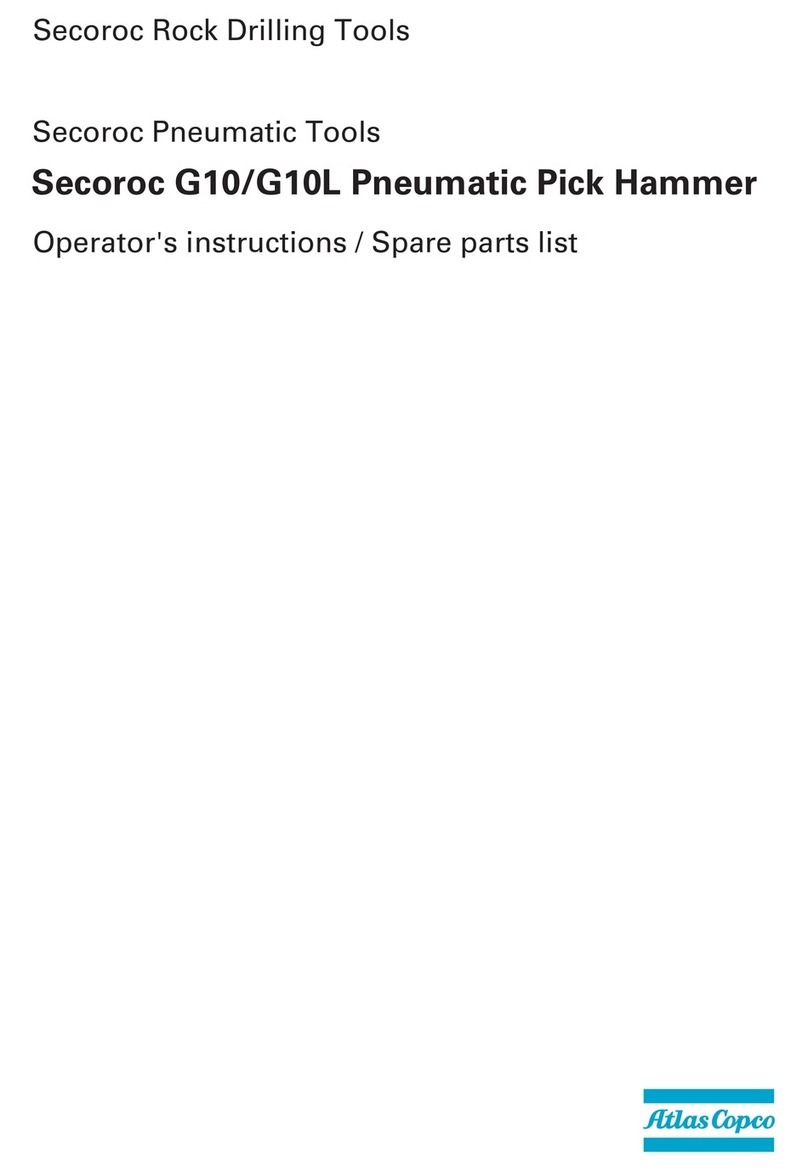
Atlas Copco
Atlas Copco Secoroc G10 Operator Instructions and Spare parts list

Asist
Asist AE1KB130DM Translation of the original operating manual
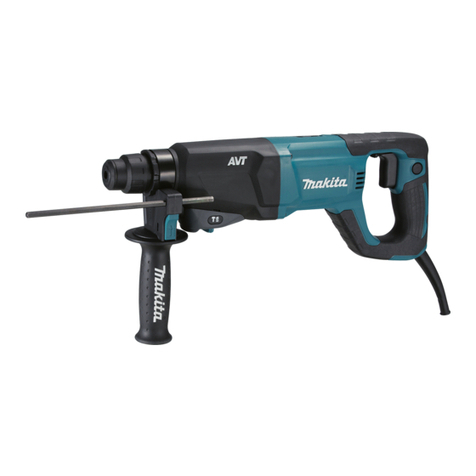
Makita
Makita HR2621 instruction manual

Hitachi
Hitachi H 65SB2 Handling instructions
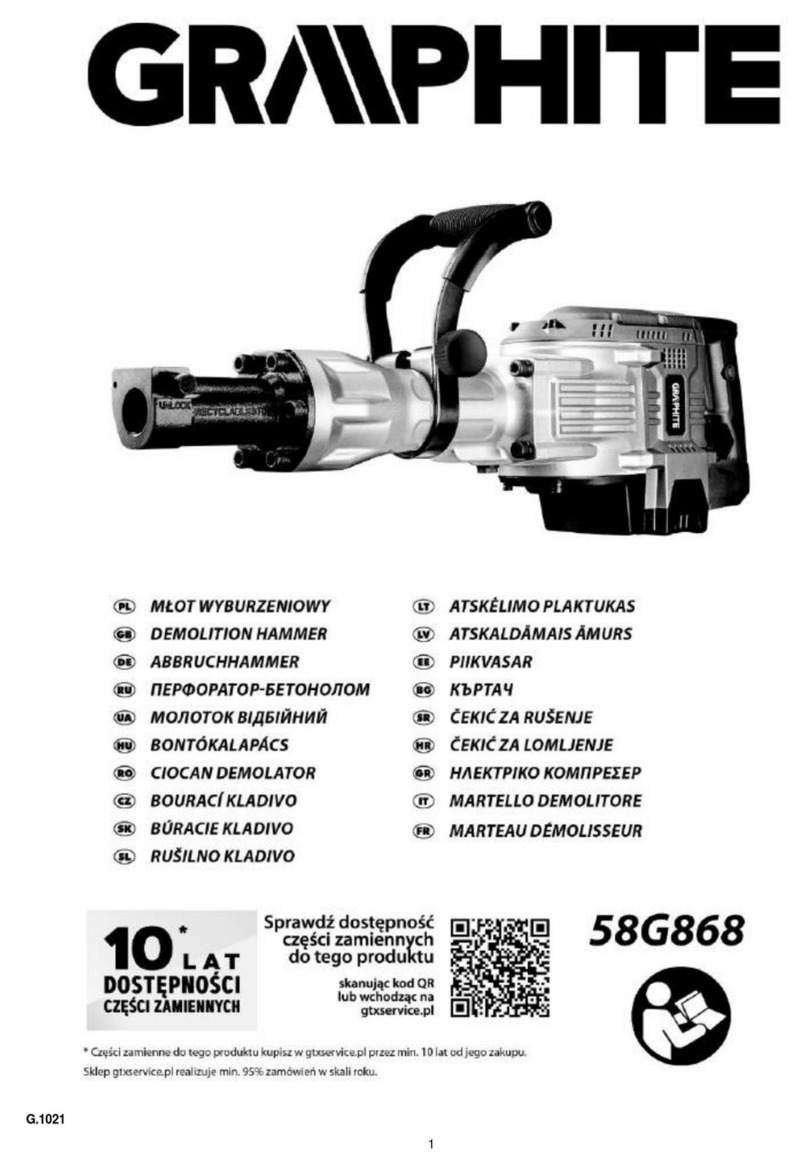
Graphite
Graphite 58G868 manual

Baileigh Industrial
Baileigh Industrial PH-28HD Operator's manual
